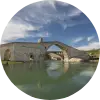
















Kavuşan Höyük is a mound located in the Bismil district of Diyarbakır province in Turkey. Situated south of the Tigris River and northeast of the Şeyhan Stream, it was first discovered in 1988 by Guillermo Algaze and his team. Subsequently, rescue excavations were carried out as part of the "Rescue Project for Archaeological Cultural Assets to be Submerged under the Ilısu and Kargamış Dam Lakes" by Middle East Technical University (METU) and the Turkish Archaeological Conservation and Research Centre (TAÇDAM).
The mound covers an area of 175 x 75 meters with a height of 8 meters in the north and 2 meters in the south. Its total area is reported to be 1.5 hectares. Due to widespread agricultural activities, the surface has been heavily damaged. The layers uncovered during the excavations reveal a long history of the mound, spanning from prehistoric times to the Islamic period.
The stratigraphy of the mound is as follows:
Layer: Modern Islamic cemetery (late 19th century, 20th century) Layer: Medieval period (12th-14th centuries) Layer: Hellenistic period (late 4th century BCE – 3rd century BCE) Layer: Post-Assyrian Period (Late Iron Age, late 7th century BCE – late 4th century BCE) Layer: Neo-Assyrian Period (9th century BCE – late 7th century BCE) Layer: Early Iron Age (11th century BCE – 9th century BCE) Layer: Mitanni - Middle Assyrian Period (Late Bronze Age, 14th century BCE – 11th century BCE) Layer: Late Bronze Age end - Middle Bronze Age (late 3rd millennium BCE – early 2nd millennium BCE) Layer: Early Bronze Age IV (late 3rd millennium BCE – mid-2nd millennium BCE)
Prominent findings from the excavations include grooved pottery from the Early Iron Age, various jewelry, and burial offerings from the Neo-Assyrian Period. Additionally, unique architectural features such as a wine storage well from the Neo-Assyrian Period have also been discovered.
These excavations provide a significant resource for understanding the cultural and archaeological richness of the region during prehistoric and ancient periods.